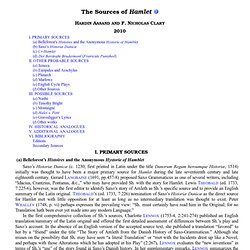

Wp-content/oxfordian/Showerman-Orestes.pdf. PMLA, Vol. 82, No. 5 (Oct., 1967), pp. 303-313. € 56 Ways of Saying I Don’t Remember’ By Alan Berliner 56 Ways of Saying I Don't Remember: Alan Berliner explores memory and forgetting in this short experimental documentary about his cousin Edwin Honig — a poet, translator and professor — and his journey through Alzheimer’s disease.

I couldn’t have made “56 Ways of Saying I Don’t Remember” about anyone but Edwin Honig. It’s the culmination of decades of deep friendship, mutual trust, family kinship, artistic kinship, countless long walks, talks and telephone conversations, often centered on Edwin’s insistence that art should always get to the heart of the matter — to the very bottom of things — an approach he valued in his life and applied to his work, and something I kept in mind throughout the making of the film.
I was with Edwin the day he agreed to donate his brain to science, for Alzheimer’s research. Edwin Honig died in May of 2011 at the age of 91. Poems by Edwin Honig “Last Poem” (1997) He wrote poems. “The Silence” (1997) for ear or mind as yet unborn to take it in. Orson Welles and Peter O'Toole discuss Hamlet - 2. Shakespeare: Original pronunciation. Richard III, a first for online film. A one-hour, pop art-inspired version of William Shakespeare's Richard III by the Australian director Philippe Mora, has been hailed by Australia's National Film and Sound Archive (NFSA) as the first movie ever created specifically for the internet – uploaded and shared online in 1996.

The master tape and a sheaf of documents in which senior Apple executives discuss the film, sent at the time by post from the company's Cupertino, California headquarters, were found in Mora's private collection in Los Angeles and given to the NFSA in Canberra in May. Mora's film, featuring 20 actors, mostly friends who worked for free, was shot on Betacam with Walter Bal, operator on Francois Truffaut's Day for Night.
The cost of the experiment – US$50,000 – was met by Peter Sterling, a New Zealand mining expert and internet entrepreneur. "They will be latecomers," he predicted. "But they have big, elephant feet. At the time, few organisations were particularly interested in Mora's Richard III. Hamlet and Meaning. I.

Either meaning is transcendentally signified, or it is not. In Hamlet, it is not. Thus Hamlet's predicament: there are no set principles upon which to act, so he must define them himself. No mean task, that. Further Proof of Shakespeare’s Hand in ‘The Spanish Tragedy’ Marsha Miller Douglas Bruster, a University of Texas professor, has identified various spelling patterns that he says strongly suggest that part of Thomas Kyd’s “ Spanish Tragedy” was written by Shakespeare.

Last year, the British scholar Brian Vickers used computer analysis to argue that the so-called Additional Passages were by Shakespeare, a claim hailed by some as the latest triumph of high-tech Elizabethan text mining. But now, a professor at the University of Texas says he has found something closer to definitive proof using a more old-fashioned method: analyzing Shakespeare’s messy handwriting. In a terse four-page paper, to be published in the September issue of the journal Notes and Queries, Douglas Bruster argues that various idiosyncratic features of the Additional Passages — including some awkward lines that have struck some doubters as distinctly sub-Shakespearean — may be explained as print shop misreadings of Shakespeare’s penmanship.
The Sources of Hamlet. The Sources of Hamlet Guide to Symbols and Abbreviations ** = will be amplified apud = according to CN = commentary notes (use search function to locate individual lines and their CNs.

DNB = Dictionary of National Biography in print and online. TLN = Through Line Number(s), © Random House, used by permission. N.b. . [ ] brackets indicate hamletworks.org editors’ comments. [[ ]] double brackets indicate brackets within quoted material. a v at the start of a siglum denotes a variorum edition, i.e. a gathering of interpretation. Hardin Aasand and F. (a) Belleforest’s Histoires and the Anonymous Hystorie of Hamblet Saxo’s Historiæ Danicæ (c. 1230; first printed in Latin under the title Danorum Regum heroumque Historiæ, 1514) initially was thought to have been a major primary source for Hamlet during the late seventeenth century and late eighteenth century.
Monty Python - Hamlet. Is There a Shakespeare Problem?: With a Reply to Mr. J. M. Robertson and Mr ... - Sir Granville George Greenwood. The Genesis of Hamlet - Charlton Miner Lewis. The Trauma of Being Alive. Robert Lepage by - ONFB. Www.complicite.org/pdfs/Teachers_Notes_Devising_Pack.pdf.
HyperHamlet - Search. Woolf Online: An Electronic Edition and Commentary on Virginia Woolf's 'Time Passes' Rowan Atkinson & Hugh Laurie - Shakespeare and Hamlet (1989) Shakespeare The Animated Tales: Hamlet.